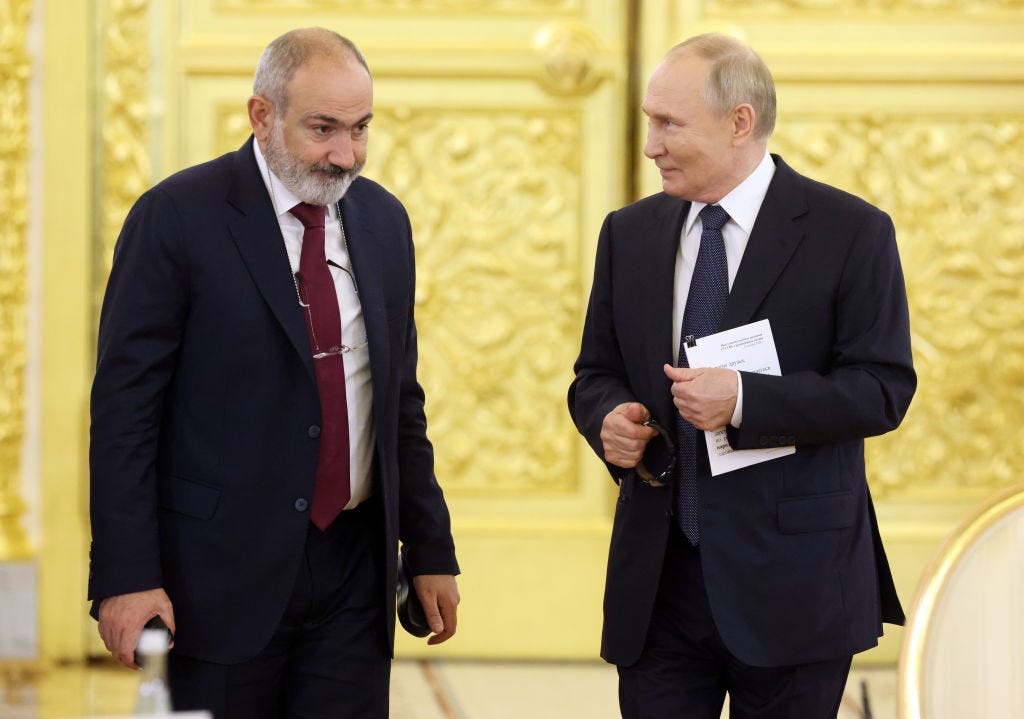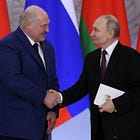Will the United States Push Russia Out of the South Caucasus?
Putin is losing his hold over traditional allies.

This article is brought to you by American Purpose, the magazine and community founded by Francis Fukuyama in 2020, which is proudly part of the Persuasion family.
Russia is not only unable to achieve any of its strategic goals in Ukraine, but it is also struggling to maintain its influence over former Soviet republics that were traditionally within its geopolitical orbit. Nowhere is that more obvious than in the South Caucasus, where two archenemies, Armenia and Azerbaijan, share one thing in common: a desire to turn their backs on the Kremlin.
The United States could find itself as a major beneficiary of ongoing geopolitical turmoil. On August 8, President Donald Trump is set to host Armenian Prime Minister Nikol Pashinyan and Azerbaijani President Ilham Aliyev in an effort to push for a long-awaited peace agreement.
In the past, it was Russia that played the role of the main mediator between the two longtime adversaries. But now with Moscow bogged down in Ukraine, Washington has a unique opportunity to strengthen its presence in the strategically important region.
As a result of the 44-day war the two nations fought in 2020 over Nagorno-Karabakh—internationally recognized as part of Azerbaijan, though it had been under Armenian control for nearly three decades—Armenia, Russia’s ally in the Collective Security Treaty Organization (CSTO), suffered a defeat. The Kremlin, for its part, did nothing to help its nominal ally, choosing to prioritize its energy ties with Baku instead. Nevertheless, Russia acted as a mediator in the conflict, helping both sides bring an end to hostilities.
According to the Moscow-brokered ceasefire agreement, Armenia and Azerbaijan are to establish the Nakhchivan corridor (also known as the Zangezur corridor), connecting mainland Azerbaijan with its Nakhchivan exclave—and further with its ally Turkey—through Armenia’s Syunik Province. Control over the transportation route is to be exercised by Russia’s Federal Security Service (FSB).
The Zangezur Corridor is considered a key link in the Trans-Caspian International Transport Route (TITR), also known as the Middle Corridor, connecting China, Central Asia, the South Caucasus, Turkey, and eventually Europe, while bypassing Russia and Iran. To this day, however, Armenia has yet to build its section of the route. Azerbaijan repeatedly insists on no Armenian presence on the corridor, even passport or customs checks. For Yerevan, such a proposal was unacceptable. But new geopolitical realities—such as the recent Israel-Iran War, Armenia’s efforts to normalize ties with Turkey, and increasingly tense relations between Russia and Azerbaijan—might force Armenia to engage in the construction of the Zangezur corridor.
Given the importance of the 32-kilometer-long corridor, and the fact that it runs along Armenia’s border with Iran, it is understandable that the United States is interested in gaining control over the route. If that happens, there will likely be no room for the FSB to oversee the corridor, which means that Washington, along with other global and regional powers—namely the European Union and Turkey—will get the opportunity to effectively crowd Russia out of the South Caucasus.
At the same time, Iran would see its north semi-encircled by Turkic states—Israel-friendly Azerbaijan and NATO member Turkey. Thus, the United States likely aims to kill two birds with one stone—to significantly reduce Russia’s presence in the region and to prepare the ground for a potential large-scale war against the Islamic Republic.
Fully aware of this, Iranian leaders have repeatedly stated that attempts to strip the Islamic Republic of its common border with Armenia are a “red line” for them. But if Yerevan and Baku eventually reach a peace deal, and agree on the construction of the Nakhchivan corridor, Tehran will be presented with a fait accompli, and its room for maneuver will be rather limited.
Besides Iran, Russia would be another loser in the event of a potential normalization of relations between the two archenemies. Since the early 1990s, when the First Karabakh War broke out, Moscow has acted as a mediator, as both Armenia and Azerbaijan were within its sphere of influence. Following the Second Karabakh War and the dissolution of the Yerevan-backed, self-proclaimed Republic of Artsakh (the Armenian name for Nagorno-Karabakh) in 2023, relations between Armenia and Russia went from bad to worse.
Yerevan views Russia’s ambivalence toward the fall of Artsakh as a betrayal. It is, therefore, no surprise that Armenia is actively looking for new allies and is threatening to leave the CSTO. In such a scenario, Russia would almost certainly have to close its military bases in Armenia, which would represent another strategic defeat for the Kremlin.
The former Soviet republic has already suspended its activities in the Russian-led military bloc, as the European Union has deployed observers along the Armenia-Azerbaijan border. More importantly, on January 14, Armenia signed a Strategic Partnership Charter with the United States, aiming to establish a comprehensive framework for cooperation between the two nations, focusing on areas including defense and security, economic development, democratic reforms, energy, technology and people-to-people relations.
Moreover, the Trump administration reportedly expects Armenia and Azerbaijan to make progress toward reaching a long-awaited peace treaty. Secretary of State Marco Rubio, according to reports, believes that a peace deal will be signed “pretty soon,” while Donald Trump claims that Washington “worked magic” in the peace talks between Yerevan and Baku, saying that the deal is “pretty close if it’s not already done.”
Although it is widely believed that Pashinyan and Aliyev could sign a peace deal on August 8, normalizing ties between Yerevan and Baku will be easier said than done. If reports that Armenian Prime Minister Nikol Pashinyan recently rejected Azerbaijani President Ilham Aliyev’s demand for an “unimpeded passage” through the Zangezur Corridor are true, it will not be that easy for the Trump administration to compel the two archenemies to sign a peace treaty. One thing is certain, though. The United States, through its diplomatic initiative, is increasing its presence in the South Caucasus.
At the same time, the European Union is deepening its involvement in Armenia, investing in the country’s “information ecosystem.” Meanwhile, Russian media operating in the South Caucasus nation could soon be shut down, as Pashinyan has accused them of “crossing all possible boundaries.”
Neighboring Azerbaijan has already taken similar actions by shutting down the Russian state media outlet Rossiya Segodnya, which operates the Sputnik and RIA Novosti news agencies. Most recently, it arrested Russian journalists working in the energy-rich nation, as Russian security forces detained and reportedly expelled dozens of people of Azerbaijani descent living and working in Russia.
Moscow is, therefore, in a spat with both Azerbaijan and Armenia, which is the result of the Kremlin’s weak diplomacy and its actions in Ukraine. The United States, Turkey, and European powers now have the chance to fill the vacuum and strengthen their presence in the South Caucasus—a critical geopolitical crossroads.
Nikola Mikovic is a freelance journalist, researcher and analyst based in Serbia.
Follow Persuasion on Twitter, LinkedIn, and YouTube to keep up with our latest articles, podcasts, and events, as well as updates from excellent writers across our network.
And, to receive pieces like this in your inbox and support our work, subscribe below:




